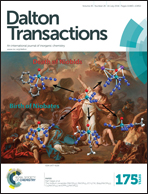2,6-Dipicolinoylbis(N,N-dialkylthioureas) as versatile building blocks for oligo- and polynuclear architectures†
Abstract
Similar reactions of 2,6-dipicolinoylbis(N,N-diethylthiourea) (H2La) with: (i) Ni(NO3)2·6H2O, (ii) a mixture of Ni(NO3)2·6H2O and AgNO3, (iii) a mixture of Ni(OAc)2·4H2O and PrCl3·7H2O and (iv) a mixture of Ni(OAc)2·4H2O and BaCl2·2H2O give the binuclear complex [Ni2(La)2(MeOH)(H2O)], the polymeric compound [NiAg2(La)2]∞, and the heterobimetallic complexes [Ni2Pr(La)2(OAc)3] and [Ni2Ba(La)3], respectively. The obtained assemblies can be used for the build up of supramolecular polymers by means of weak and medium intermolecular interactions. Two prototype examples of such compounds, which are derived from the trinuclear complexes of the types [MII2LnIII(L)2(OAc)3] and [MII2Ba(L)3], are described with the compounds {[CuII2DyIII(La)2(p-O2C-C6H4-CO2)(MeOH)4]Cl}∞ and [MnII2Ba(MeOH)(Lb)3]∞, H2Lb = 2,6-dipicolinoylbis(N,N-morpholinoylthiourea).


 Please wait while we load your content...
Please wait while we load your content...